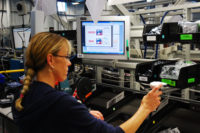An independent group called the Aerospace Automation Consortium (AAC) was created in 2003 to address industry needs and create dialogue on common manufacturing challenges. The group includes aircraft manufacturers, such as Boeing, Lockheed Martin and Northrop Grumman, and production equipment suppliers, such as Advanced Integration Technology Inc., M. Torres and Nova-Tech Engineering LLC.
ASSEMBLY magazine contacted several AAC members for input on the “High-Flying Robots” article (May 2009), but they did not respond. However, the consortium recently issued a six-page white paper (a portion is excerpted below) that outlines some key industry challenges:
Automation Technology
a) Precision articulated-arm automation.
i) Key enabler for reduced footprint, facility and tooling requirements leading to improved access to airframe for both the automated system and the mechanic.
ii) Utilizing as much commercial off-the-shelf (COTS) equipment as possible leads to reduced cost, complexity, maintenance and system lead times.
iii) Reduced reliance on line of sight metrology for high accuracy applications is preferred. Reduced hole to hole compensation.
iv) High-accuracy articulated-arm automation for “point operations” (i.e., drilling, fastener installation and inspection) and for “path operations” (i.e., milling, material dispensing and inspection) in aerospace material types and dissimilar stack-ups.
b) Portable, low-cost automation capable of holding tight tolerances is needed to address prototype and low production rate environments.
i) Specific applications will drive final requirements, but accuracies in the range of +/- 0.003 inch are projected for many aerospace applications.
c) Volumetric compensation for large working volumes.
i) A volumetric compensation method of electronically enhancing the volumetric accuracy of CNC machine tools and serial robots is needed to enable the supply base to produce parts with tolerances down to +/- 0.001 inch or less.
ii) Tolerances continue to reduce due to reduced margins in aircraft for weight optimization and determinate assembly objectives.
iii) Volumetric accuracy is a function of all the machine tool geometric error components throughout the entire working volume. Because it considers the whole volume, volumetric accuracy is a more detailed approach than volumetric error indicators, such as the diagonal test specified in ISO 230-6.
iv) Volumetric error at any point in the working volume is calculated, using a set of rigid-body equations, as a function of the measured geometric errors and axis position The volumetric accuracy is the worst of the volumetric errors and in simple terms, if volumetric accuracy is less than component tolerance, the machine tool is capable of producing the part.
Assembly and Process Technology
a) Introduction.
i) There is a wide variety of processes required to assemble modern aircraft, including structure joining, subsystem installation, system check-out and process inspection. Much of the work accomplished on the assembly line is supported by personnel and suppliers also requiring technological improvements.
b) Fastener treatment and kitting.
i) Current aircraft assembly processes utilize numerous mechanical fasteners to join structure. These mechanical fasteners require a cleaning treatment and also may require fuel tank sealant applied prior to installation. Sorting-kitting of the fasteners requires knowledge of the engineering designs, along with any changes during assembly, such as grip length or diameter.
ii) The near-term approach is to develop digital methods of collecting the grip length and hole diameter information. This would allow an automated process for any change board activities and to schedule kits. Systems could then use the kits to perform any preparation-treatment activity.
c) New mechanical fastening systems.
i) To save weight on aircraft assemblies, two-sided permanent mechanical fasteners are used even in confined spaces. This is allowable due to the variety of special tools and the dexterity of humans. One-sided fasteners with comparable strength and weight as two-sided fasteners could further expand automation processes to areas that are labor intensive.
ii) In order to better associate fasteners with particular hole diameters a process is needed that will prepare or sort fasteners for application in the most appropriately-sized hole for installation.
d) Bonding of major composite structure.
i) As aerospace moves toward large composite structures, bonding processes are needed to join critical, load-bearing aircraft structure. These bonds should be accomplished with minimal heat, no autoclave and simple preparation-application processes.
ii) Near-term technologies of interest include surface preparation processes, quick vacuum bagging processes and nondestructive bond inspection methods.
e) Alternative hole drilling processes.
i) The need for drilling holes in the aerospace industry will remain for a very long time. Maintenance panels, assembly sequences and damage repair all require the need for removable mechanical fasteners. Current drilling processes include standard geometry cutters with multiple flutes. These cutters dull and have specific applications (one cutter size per hole size).
Some potential alternative methods for creating holes in aircraft structure are:
(1) Ultrasonic drilling.
(2) Laser drilling.
(3) Orbital drilling.
ASSEMBLY magazine contacted several AAC members for input on the “High-Flying Robots” article (May 2009), but they did not respond. However, the consortium recently issued a six-page white paper (a portion is excerpted below) that outlines some key industry challenges:
Automation Technology
a) Precision articulated-arm automation.
i) Key enabler for reduced footprint, facility and tooling requirements leading to improved access to airframe for both the automated system and the mechanic.
ii) Utilizing as much commercial off-the-shelf (COTS) equipment as possible leads to reduced cost, complexity, maintenance and system lead times.
iii) Reduced reliance on line of sight metrology for high accuracy applications is preferred. Reduced hole to hole compensation.
iv) High-accuracy articulated-arm automation for “point operations” (i.e., drilling, fastener installation and inspection) and for “path operations” (i.e., milling, material dispensing and inspection) in aerospace material types and dissimilar stack-ups.
b) Portable, low-cost automation capable of holding tight tolerances is needed to address prototype and low production rate environments.
i) Specific applications will drive final requirements, but accuracies in the range of +/- 0.003 inch are projected for many aerospace applications.
c) Volumetric compensation for large working volumes.
i) A volumetric compensation method of electronically enhancing the volumetric accuracy of CNC machine tools and serial robots is needed to enable the supply base to produce parts with tolerances down to +/- 0.001 inch or less.
ii) Tolerances continue to reduce due to reduced margins in aircraft for weight optimization and determinate assembly objectives.
iii) Volumetric accuracy is a function of all the machine tool geometric error components throughout the entire working volume. Because it considers the whole volume, volumetric accuracy is a more detailed approach than volumetric error indicators, such as the diagonal test specified in ISO 230-6.
iv) Volumetric error at any point in the working volume is calculated, using a set of rigid-body equations, as a function of the measured geometric errors and axis position The volumetric accuracy is the worst of the volumetric errors and in simple terms, if volumetric accuracy is less than component tolerance, the machine tool is capable of producing the part.
Assembly and Process Technology
a) Introduction.
i) There is a wide variety of processes required to assemble modern aircraft, including structure joining, subsystem installation, system check-out and process inspection. Much of the work accomplished on the assembly line is supported by personnel and suppliers also requiring technological improvements.
b) Fastener treatment and kitting.
i) Current aircraft assembly processes utilize numerous mechanical fasteners to join structure. These mechanical fasteners require a cleaning treatment and also may require fuel tank sealant applied prior to installation. Sorting-kitting of the fasteners requires knowledge of the engineering designs, along with any changes during assembly, such as grip length or diameter.
ii) The near-term approach is to develop digital methods of collecting the grip length and hole diameter information. This would allow an automated process for any change board activities and to schedule kits. Systems could then use the kits to perform any preparation-treatment activity.
c) New mechanical fastening systems.
i) To save weight on aircraft assemblies, two-sided permanent mechanical fasteners are used even in confined spaces. This is allowable due to the variety of special tools and the dexterity of humans. One-sided fasteners with comparable strength and weight as two-sided fasteners could further expand automation processes to areas that are labor intensive.
ii) In order to better associate fasteners with particular hole diameters a process is needed that will prepare or sort fasteners for application in the most appropriately-sized hole for installation.
d) Bonding of major composite structure.
i) As aerospace moves toward large composite structures, bonding processes are needed to join critical, load-bearing aircraft structure. These bonds should be accomplished with minimal heat, no autoclave and simple preparation-application processes.
ii) Near-term technologies of interest include surface preparation processes, quick vacuum bagging processes and nondestructive bond inspection methods.
e) Alternative hole drilling processes.
i) The need for drilling holes in the aerospace industry will remain for a very long time. Maintenance panels, assembly sequences and damage repair all require the need for removable mechanical fasteners. Current drilling processes include standard geometry cutters with multiple flutes. These cutters dull and have specific applications (one cutter size per hole size).
Some potential alternative methods for creating holes in aircraft structure are:
(1) Ultrasonic drilling.
(2) Laser drilling.
(3) Orbital drilling.




